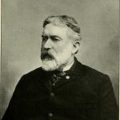Sébastien Vaillant
The Structure of Flowers
May 26, 1669
Today is the birthday of the French botanist Sébastien Vaillant.
Appointed to the King’s garden in Paris, Sebastien loved organizing and cataloging plants. Biographical accounts say Sebastian showed a passion for plants from the age of five.
His masterpiece, forty years in the making, Botanicon Parisienne, was a book about the flora of Paris. It wasn’t published until five years after his death.
Today, Sebastian Vaillant is credited for acknowledging the importance of the sexual anatomy of plants. Sebastian’s work on plant sexuality inspired generations of botanists and set the stage for Linneaus to develop his sexual system of plant classification. Linnaeus used the male stamens to determine the class and the female pistils to determine the order.
And like Sebastion, Linnaeus often compared plant sexuality to that of humans. Linnaeus wrote,
“Love even seizes... plants... both [males and females], even the hermaphrodites, hold their nuptials, which is what I now intend to discuss.”
Sebastian caused a sensation when he presented his work on plant sexuality at the Royal Garden in Paris on June 10, 1717. He began by reinforcing the idea that the flower is the most important part of a plant - essential to reproduction - and then he began to lead his scientific colleagues down a path they had never thought to follow. His lecture was titled, Lecture on the Structure of the Flowers: Their Differences and the Use of Their Parts.
Today, we can imagine the reaction of his 600 person audience as he began using fairly explicit language and the lens of human sexuality to describe the sex lives of plants - at six in the morning, no less. Before Sebastian’s lecture, the topic of sex in the plant world had only been touched on lightly, allowing flowers and blossoms to maintain their reputation as pure, sweet, and innocent.
Sebastian was no fool. He knew his lecture would cause a stir. In a 2002 translation of his speech presented in A Journal of Botanical History known as Huntia, Sebastian began his lecture by acknowledging that he was going to talk about plant sexuality very explicitly, saying,
“Perhaps the language I am going to use for this purpose will seem a little novel for botany, but since it will be filled with terminology that is perfectly proper for the use of the parts that I intend to expose, I believe it will be more comprehensible than the old fashioned terminology, which — being crammed with incorrect and ambiguous terms better suited for confusing the subject than for shedding light on it — leads into error those whose imaginations are still obscured, and who have a poor understanding of the true functions of most of these structures.”
It wasn’t all salacious. Sebastian’s discussion of plant embryos was rather poetic. The shapes he references are the shapes of the pollen grains. Sebastian remarked,
“Who can imagine that a prism with four faces becomes a Pansy; a narrow roll, the Borage; a kidney, the Daffodil; that a cross can metamorphose into a maple; two crystal balls intimately glued to each other, [Comfrey], etc.? These are nevertheless the shapes favored, in these diverse plants, by their lowly little embryos.”
Sebastian Valliant is especially remembered for his work with the male and female pistachio tree to demonstrate pollination and the sexuality of plants. At the time of Sebastian’s work, the pistachio was growing in the King’s garden and had managed to survive the harsh winters of Paris.
The slow-growing pistachio tree is deciduous and dioecious. This means that a pistachio tree can have only male flowers or female flowers.
Only female trees produce fruits, and female trees are wind-pollinated by pollen from the male tree. In a perfect world, there would be one male pistachio tree centrally located near nine female pistachio trees.
As for telling the trees apart, male pistachio trees are taller, hold on to their leaves longer in the fall, and generally more robust than female pistachio trees.
In terms of fruiting, pistachios grow in clusters, like grapes. Trees need seven years of growing before reliably producing a good yield. But, once they get started, pistachios can produce fruit for over a hundred years.
This post was featured onThe Daily Gardener podcast:
helping gardeners find their roots,
one story at a time






